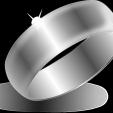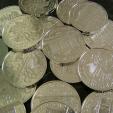Silver Seen Starting Slow, Then Gaining Speed Toward End Of 2015
San Francisco (Dec 15) Silver could struggle in the early part of 2015 as markets continue to factor in expectations for Federal Reserve tightening and as growth in industrial demand remains constrained by soft economies in other parts of the world.
But by the end of the year, many analysts see silver regaining its luster on ideas that any Fed rate hikes are likely to be modest and industrial demand may start picking up, assuming the economy shows improvement.
For instance, TD Securities sees silver averaging $15.50 an ounce in the first quarter but $19.50 in the fourth. Commerzbank looks for the second quarter to be the weakest of the year with an average $16 forecast, but for improvement to $18 in the fourth quarter.
Some of the average full-year 2015 forecasts made by firms so far include Natixis, $15.20; Citi Research, $16.50; Commerzbank, $17; HSBC, $17.65; and TD Securities, $17.81. Among consultancies, Metals Focus looks for $16.20 and CPM Group $16.65.
There are two key aspects to silver demand – investment as a financial-type instrument, similar to gold, and also industrial uses that account for slightly more than half of global silver demand.
“On the financial side, we still see a strengthening U.S. dollar through next year,” said Jessica Fung, commodity analyst with BMO. “And when we see a strengthening U.S. dollar, we tend to also see a decline in gold and silver prices.”
The dollar has been boosted by expectations that the Federal Reserve will start hiking interest rates around the middle of 2015 after already ending its bond-buying program known as quantitative easing. This supports the greenback on interest-rate differentials, especially since the Bank of Japan and European Central Bank remain accommodative.
Meanwhile, silver industrial demand has been held back by economic weakness in parts of the world, including the eurozone and Japan, said Philip Newman, director of the consultancy Metals Focus.
“Are we going to see silver industrial demand contract next year?” he asked rhetorically. “I don’t think so. But you may see it grow at a slower pace than in 2014.”
However, there is a factor countering this so far, he continued, listing strong physical demand from retail investors. The U.S. Mint said American Eagle silver coin sales already hit a record high for the year. Also, Indian silver imports have been strong since last year, when the government enacted curbs on gold imports to combat a large current-account deficit.
Meanwhile, should the Federal Reserve hike interest rates as currently expected, this is likely to have a “psychological” impact on precious metals more-so than actually impacting economic growth materially, said Rohit Savant, director of research with the consultancy CPM Group.
“That’s if they increase interest rates,” he added. “There’s always the possibility that they don’t….But if they do, it will probably be a very small increase, which really won’t have that much effect. That would weigh on prices, at least initially. Then we see prices improving a little possibly toward the fourth quarter of the year and into 2016.”
Newman and TDS also said any Fed rate hikes are expected to be benign.
“The reasoning is that the FOMC is unlikely to get too restrictive given the headwinds from external sources, implying real rates should not rise very much,” TDS said. “If U.S. inflation moves higher, which it should under our U.S./global growth scenario, along with a reduction in the U.S. output gap in H1-2015, the cost of carry for gold and silver may not rise as much as many real money traders and specs think.”
Commerzbank said the pressure on gold prices also abated during the Federal Reserve’s last series of rate hikes between 2004 and 2006.
Once rates rise, that presumably will take away some of the market uncertainty about what to expect, Newman pointed out. There is an old adage that markets do not like uncertainty.
“That may encourage investors to revisit gold a little bit – nothing dramatic, but just enough to suggest that we do see the lows in the market somewhere around Q2 or Q3 of next year,” Newman said. And, if gold rises, silver tends to follow suit.
Further, weak prices during the earlier part of the year might be seen as a “value” to silver-market participants, Savant added.
Plus, if modest rate hikes do not slow economic growth materially, industrial demand should pick up, Savant said. Also, an improving economy would portend future inflation, which in turn could translate into buying of gold and silver as an inflation hedge.
Seasonal demand also would start picking up again for gold and silver in the latter part of 2015, Newman said. This is due to buying related to autumn holidays and the so-called wedding season in India, the start of buying ahead of Chinese New Year celebrations, and a pickup in Western demand ahead of Christmas.
Fabrication Demand Seen Rising; Scrap Supply May Decline
Most analysts look for a silver-market supply surplus this year, although those that factor in investment demand look for a small one. When including investment such as exchange-traded products, TD Securities looks for a 21 million-ounce surplus in 2015, while HSBC anticipates an 11 million deficit. Both estimates are small considering silver is roughly a 1 billion-ounce-per-year market.
Most analysts expect another uptick in mine supply next year, although a small one, while HSBC looks for a pullback. Most also look for an increase in fabrication demand.
“Scrap supply is likely to be flat or declining because you have these weaker prices,” Savant said. “There really is no major incentive to recycle or sell, especially silver coming out of jewelry.”
Scrap tends to be price sensitive, meaning people are more likely to sell or recycle their silver when prices are high but less inclined when they are low. HSBC looks for scrap to fall to 155 million ounces from 163 million this year; it peaked at 259 million back in 2011.
“That (scrap) is one area that tends to be glossed over by a number of people in the market,” Fung said. “The scrap portion of the market represents 20% to 22% of the supply side.”
Gold-silver Ratio May Remain High Early In Year
Analysts look for the gold/silver ratio to remain high in the early months of the year, which means silver is underperforming the yellow metal. However, some – such as TDS – see the ratio declining later in the year as both metals start to recover.
The ratio measures the number of ounces of silver it takes to buy an ounce of gold. When it rises, silver is underperforming, and vice-versa. As of late last week, the ratio stood around 71.5, compared to roughly the 60 area much of the time in recent years.
“There have some analysts who have said, ‘the ratio is too high; it must come down,’” Fung said. “But historically, when the U.S. dollar is strengthening, that ratio tends to increase. It points to the fact that the silver price tends to be more leveraged to the U.S. dollar than gold. It’s twice as volatile. When gold prices move down in relation to the U.S. dollar, silver tends to move down more.
“That being said, if the U.S. dollar moves into a weaker trend, which could occur in 2016-17 when Europe and Japan come back, gold prices will improve. And silver prices will improve even more.”
TDS looks for silver to underperform gold in the short term, but then to gain the upper hand as investors become more interested in precious metals again.
Source: KitcoNews












